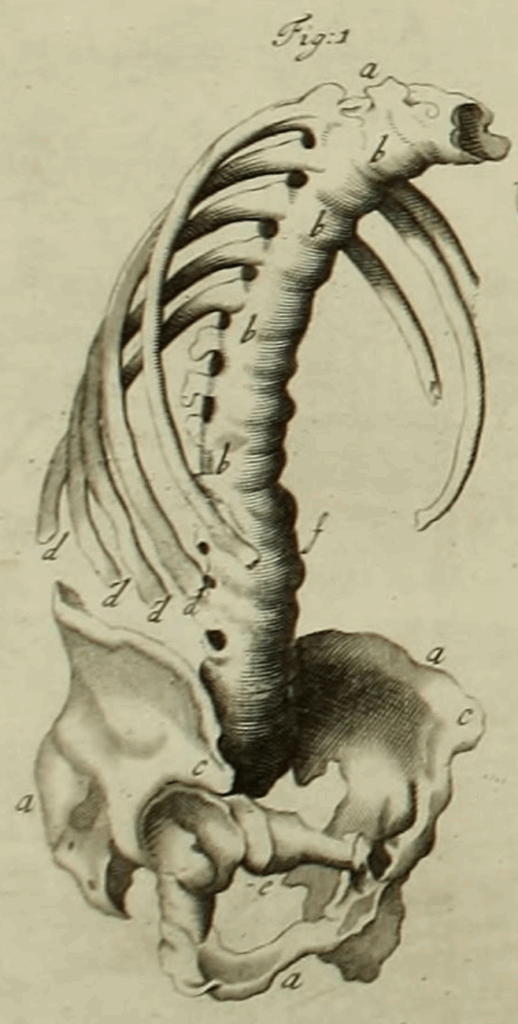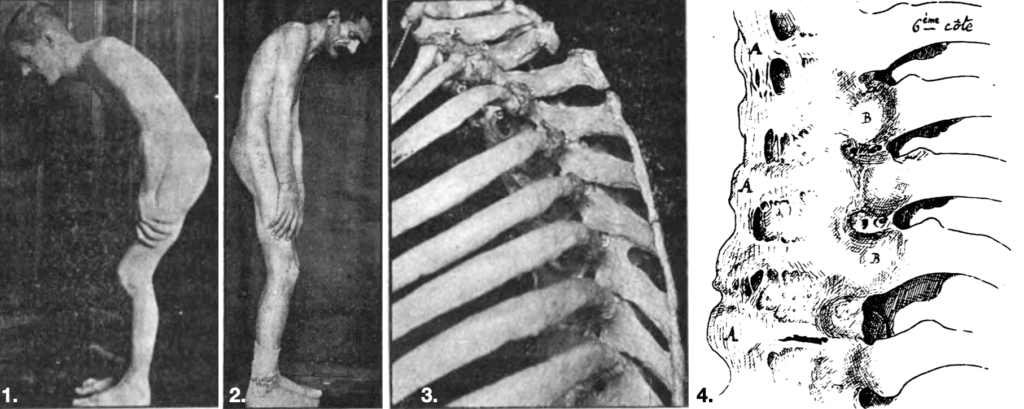Marie-Strümpell disease
Marie-Strümpell disease, also known as ankylosing spondylitis (AS), is a chronic, progressive inflammatory spondyloarthropathy that primarily affects the axial skeleton. It characteristically begins in young adulthood and is associated with low back pain, stiffness, and eventual spinal ankylosis.
The condition most frequently affects the sacroiliac joints and lumbar spine and is strongly associated with HLA-B27 positivity. Extra-articular manifestations include uveitis, aortitis, and enthesitis.
The eponym acknowledges Adolf von Strümpell (1853–1925), who described the spinal ankylosis and hip involvement, and Pierre Marie (1853–1940), who expanded the nosology and highlighted the ascending nature of the disease’s progression. Vladimir Bekhterev (1857–1927) also described similar findings independently, resulting in regional variations in the naming of the disease: Marie-Strümpell disease in Western Europe, Bekhterev’s disease in Russia and Eastern Europe, and ankylosing spondylitis in English-speaking countries.
History of Marie-Strümpell disease
1693 – Bernard Connor (1666–1698) while demonstrating in anatomy in France, was told of an unusual skeleton that had been found in a local cemetery. It consisted of the os ilium, os sacrum, five lumbar vertebrae, ten thoracic vertebrae, with five right and three left ribs, all firmly united at ‘the joinings‘ so that they made one uniform continuous bone. Connor describes
a layer of new bone may be seen covering the whole length of dorsal and lumbar spine as if some soft liquid osseous material had been poured over them and this had subsequently hardened

Represents the Sceleton withs the Vertebrae of the Back and Ribs united.
a, b, c. The Vertebrae of the neck, back and Ossa Illium, all joined together
d. Several of the Ribs united to the Back—bone. Connor 1695
1850 – Sir Benjamin Brodie (1783–1862) described ankylosis in Case LXXILI in the fifth edition of Pathological and Surgical Observations on the Diseases of the Joints.
Every one who is conversant with pathological museums must have seen specimens in which the bodies of a greater or smaller number of vertebrae are firmly ankylosed, there being at the same time a deposit of bony matter here and there on the surface adhering to the bone beneath, and extending from one vertebra to the other.
Brodie was the first to describe the clinical features of the ankylosing condition in a 31 year old male who complained of pain and stiffness in the dorsal and lumbar spine, buttocks, and thighs. Brodie treated him with mercury, iodides, and sarsparilla, and the disease gradually burned itself out over a period of years, so that eventually the patient was left without symptoms except for “a rigid and inflexible spine“.
He complained of pain referred to the spine from the neck downwards, but especially to the middle dorsal vertebrae. When he attempted to stoop, he experienced a sense of stiffness of the spine, and there was scarcely any perceptible flexure of it, the stooping being apparently confined to the motion of the pelvis on the thigh. A sudden motion had often occasioned an aggravation of the pain in the spine, and on all occasions pain was induced by the act of sneezing, which therefore he carefully avoided.
The progress of the disease was tedious, extending, when I had the opportunity of watching it, over a period of several years, and it terminated in leaving the spine of its natural figure, but completely rigid and inflexible through the greater part of its extent.
1884 – Adolf von Strümpell (1853–1925) briefly described the disease in his chapter on Der chronische Gelenkrheumatismus (chronische Polyarthritis) und die Arthritis deformans, where he observed progressive stiffening and fusion of the spinal joints.
Als ein merkwürdiges und, wie uns scheint, eigenartiges Leiden mag hier beiläufig noch diejenige Erkrankungsform erwähnt werden, bei welcher es ganz allmählich und ohne Schmerzen zu einer vollständigen Ankylose der ganzen Wirbelsäule und der Hüftgelenke kommt, so dass Kopf, Rumpf and Oberschenkel fest mit einander verbunden und vollkommen steif sind, während alle übrigen Gelenke ibre normale Bewegliehkeit behalten. Dass hierdurch ganz eigenthümliche Modificationen der Körperhaltung und des Ganges entstehen müssen, liegt auf der Hand. Wir selbst haben zwei ganz gleiehartige Fälle dieser eigenthümlichen Krankheit gesehen.
As a remarkable and, as it seems to us, peculiar ailment…in which there is a complete ankylosis of the whole spine and the hip joints very gradually and without pain, so that the head, trunk and thighs are firmly together connected and perfectly rigid while all remaining joints retain their normal mobility. It is obvious that this results in very peculiar modifications of posture and gait. We ourselves have seen two very similar cases of this peculiar disease.
1893 – Vladimir M. Bekhterev (1857–1927) published Steifigkeit der Wirbelsäule und ihre Verkrümmung als besondere Erkrankungsform, detailing spinal rigidity and deformity.
1897 – Strümpell published Bemerkung über die chronische ankylosirende Entzündung der Wirbelsäule und der Hüftgelenke detailing another case study of a patient with the disease in more detail., reinforcing chronic axial arthropathy.
1898 – Pierre Marie (1853–1940) made several foundational distinctions that shaped the clinical identity of ankylosing spondylitis in his publication on spondylose rhizomélique. He noted rigidity of the chest, the spine being ‘fait rigide comme un baton‘; and autopsy demonstratged the spine had ‘L’ossification tout particulièrement localisée aux ligaments; aux bourrelets et aux menisques articulaires‘.
Marie essentially defined a distinct clinical entity and isolated the disease from other spinal disorders emphasising an ascending pattern of spine involvement moving from the sacroiliac region upward to the cervical spine. He differentiated it from osteoarthritis and rheumatoid arthritis, noting:
- Symmetrical fusion of vertebral bodies and sacroiliac joints
- Sparing of large peripheral joints in early disease
- Absence of erosive changes typically seen in rheumatoid arthritis
Marie also correlated clinical and radiologic features (even before widespread use of X-rays), describing:
- Persistent, inflammatory low back pain and stiffness
- Marked limitation of spinal mobility
- Kyphotic deformity in advanced stages

3. Ossification of the supraspinous ligament
4. A: Ossification of the large anterior ligament; B: Heads of the vertebrae connected to the vertebrae by ossification of their ligaments. Marie 1898
1920s–1940s: Recognition of sacroiliac involvement by Forestier, Scott, and Hare. Radiologic correlation with disease onset established.
Associated Persons
- Bernard Connor (1666–1698): First anatomical description of vertebral fusion in a cadaver.
- Vladimir M. Bekhterev (1857–1927): Russian neurologist. Independently described the disease in similar terms.
- Adolf von Strümpell (1853–1925): German internist and neurologist. First to describe the spinal and hip manifestations as a unified disease.
- Pierre Marie (1853–1940): French neurologist. Defined the ascending spinal pattern and distinguished AS from other arthritis types.
Alternative names
- Ankylosing spondylitis
- Bekhterev disease
- HLA-B27
- Rhizomelic spondylosis
References
Historical references
- Connor B. An extract of a letter to Sir Charles Walgrave, published in French at Paris: Giving an account of an extraordinary humane sceleton, whose vertebrae of the back, the ribs and several bones down to the os sacrum, were all firmly united into one solid bone, without joynting or cartilage. Philosophical transactions 1695; 19: 21-27.
- Brodie B. Case LXXILI In: Pathological and surgical observations on the diseases of the joints. 5e 1850
- Strümpell A. Der chronische Gelenkrheumatismus (chronische Polyarthritis) und die Arthritis deformans In: Lehrbuch der speziellen Pathologie und Therapie der inneren Krankheiten. 1884.
- Bekhterev V. Steifigkeit der Wirbelsäule und ihre Verkrümmung als besondere Erkrankungsform. Neurologisches Centralblatt, 1893; 12: 426-434.
- Strümpell A. Bemerkung über die chronische ankylosirende Entzündung der Wirbelsäule und der Hüftgelenke. Deutsche Zeitschrift für Nervenheilkunde. 1897; 11: 338–342
- Marie P. Sur la spondylose rhizomélique. Revue de médecine, 1898, 18: 285-315
Eponymous term review
- Borak J. Significance of the Sacroiliac Findings in Marie-Strümpell’s Spondylitis. Radiology 1946; 47(2): 128–141.
- O’Connell D. Ankylosing spondylitis; the literature up to the close of the nineteenth century. Ann Rheum Dis. 1956 Jun;15(2):119-23.
- Baruch S. Blumberg JL. Blumberg BC. Bernard Connor (1666–1698): And His Contribution to the Pathology of Ankylosing Spondylitis, Journal of the History of Medicine and Allied Sciences, 1958; 13(3): 349–366
- Zorab P. The historical and prehistorical background of ankylosing spondylitis. Proc. R. Soc. Med. 1961;54:415–420
- Spencer D, Sturrock R, Buchanan W. Ankylosing spondylitis: yesterday and today. Med. Hist. 1980;24(1):60 – 69
- Akgül Ö, Özgöçmen S. A brief history of ankylosing spondylitis. Advances in the Management of Ankylosing Spondylitis. 2013 Jul;6-13
eponymictionary
the names behind the name
BA MA (Oxon) MBChB (Edin) FACEM FFSEM. Emergency physician, Sir Charles Gairdner Hospital. Passion for rugby; medical history; medical education; and asynchronous learning #FOAMed evangelist. Co-founder and CTO of Life in the Fast lane | On Call: Principles and Protocol 4e| Eponyms | Books |
